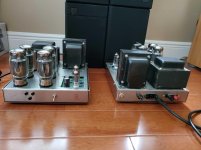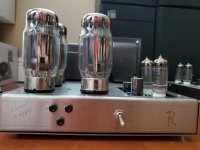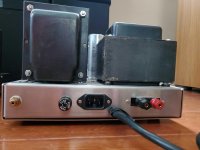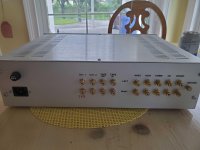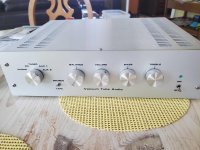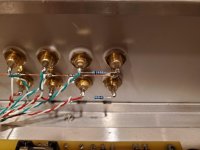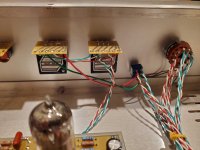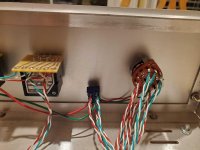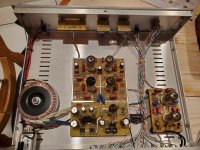I recently purchased a pair of what appear to be DIY mono block tube amplifiers. I am not a tube person, so I have very little idea what I have, and how best to use them.
Each one has 4 KT120 tubes. there is also a switch labeled Triode & Pentode, labels pointing to screw slot rotary dials labeled bias.
So, how can get a better understanding regarding what these devices are? They have not been used in a while, but were probably used within the last 2-3 years. Here are my initial questions, some of which may not have obvious answers based on the description above & pictures below.
Each one has 4 KT120 tubes. there is also a switch labeled Triode & Pentode, labels pointing to screw slot rotary dials labeled bias.
So, how can get a better understanding regarding what these devices are? They have not been used in a while, but were probably used within the last 2-3 years. Here are my initial questions, some of which may not have obvious answers based on the description above & pictures below.
- Is it safe to plug them into 110v, or should I find a Variac and power them up slowly?
- Any way to know whether it is safe to drive 4 ohm speakers for testing?
- Any guess as to the output power? I assume it would be different for Triode vs Pentode.
- I see the holes in front of the amp, I assume they are for setting the bias. How important is setting the bias? Does it need to be done as soon as the devices are powered on after not being used for a while?
Attachments
Last edited:
- I would use a variac just to be on the safe side.
- Will be safe for testing purposes, but probably optimised for 8 ohm.
- 160W in pentode mode each amp.
- Bias should be checked straight away.
This is a pair of M-125 from tubes4hifi.com Congrats !I recently purchased a pair of what appear to be DIY mono block tube amplifiers. I am not a tube person, so I have very little idea what I have, and how best to use them.
Each one has 4 KT120 tubes. there is also a switch labeled Triode & Pentode, labels pointing to screw slot rotary dials labeled bias.
So, how can get a better understanding regarding what these devices are? They have not been used in a while, but were probably used within the last 2-3 years. Here are my initial questions, some of which may not have obvious answers based on the description above & pictures below.
- Is it safe to plug them into 110v, or should I find a Variac and power them up slowly?
- Any way to know whether it is safe to drive 4 ohm speakers for testing?
- Any guess as to the output power? I assume it would be different for Triode vs Pentode.
- I see the holes in front of the amp, I assume they are for setting the bias. How important is setting the bias? Does it need to be done as soon as the devices are powered on after not being used for a while?
Your questions :
1/ yes, plug them in
2/ yes
3/125watt
4/ that is bias test pints. Mail to bob at tubes4hifi to get the manual and
instructions.
This is a pair of M-125 from tubes4hifi.com Congrats !
Your questions :
1/ yes, plug them in
2/ yes
3/125watt
4/ that is bias test pints. Mail to bob at tubes4hifi to get the manual and
instructions.
Thanks for your help.
I also picked up a "Vacuum Tube Audio" preamp. It looks close to the SP12 sold by tubes4hifi, but the source/tape selector and source selectors seem to be swapped.
Another oddity is I found that the rear has hand lettered "Sub" under Out 1. Was/is there an option to have dual sub outs? If so is there a built-in active crossover? Or do you think it is just full range and labeled "Sub" for convenience?
Attachments
It appears I have purchased a VTA - SP12. Since the layout is different from the current items on the tubes4hifi home page website, I assumed there was a minor design change. I finally got around to plugging it in along with the 2 M125s I picked up at the same time. I was testing the rig with a pair of KEF 101/2s (4 ohm) I use for testing. Everything was clean sounding, no hums or scratchiness in the controls. There were two items I would like to ask about, however.
I have connected my cellphone directly to the input on SS amps and an ST70 with much higher volume with the KEF speakers in the past (adjustable using the cell phone volume). I will try the same with the M125s to see what happens.
My target speakers for this system is a pair of Klipsch Cornwall IIIs which are about 16 DB more efficient than the KEFs. Unfortunately I haven't figured out where to put the system yet.
- The Balance knob seems to be reversed (turn to the left the right channel plays & vice versa). When I opened the case everything looked reasonable. See the pictures below. What would you recommend is the best solution for a person with modest to non existent soldering skills?
- I was using a cell phone as a source connected to Aux 2. In order to get appreciable volume I needed to "crank" the volume up to about half. I believe that connecting to Out 2 seemed better. I noticed the resistors between Out 2 & Out 1. I assume this would have the affect of attenuating the output level on Out 1. How much does that impact the power delivered to the amplifiers?
I have connected my cellphone directly to the input on SS amps and an ST70 with much higher volume with the KEF speakers in the past (adjustable using the cell phone volume). I will try the same with the M125s to see what happens.
My target speakers for this system is a pair of Klipsch Cornwall IIIs which are about 16 DB more efficient than the KEFs. Unfortunately I haven't figured out where to put the system yet.
Attachments
If the balance pot is backwards, the easiest thing to do would be to just switch the input and output cables and not think about it anymore.
The second output is labeled for subwoofers duty because it has some extra series resistance, so it's slightly less suitable for driving long cables and not having treble rolloff issues. These resistors are not there to pad down the second output and if you hear a major level difference between the two outputs, I would be very surprised.
The position of the volume pot relative to system loudness is meaningless.
Klipsch Cornwalls would be a horrible choice for what you have here.
The second output is labeled for subwoofers duty because it has some extra series resistance, so it's slightly less suitable for driving long cables and not having treble rolloff issues. These resistors are not there to pad down the second output and if you hear a major level difference between the two outputs, I would be very surprised.
The position of the volume pot relative to system loudness is meaningless.
Klipsch Cornwalls would be a horrible choice for what you have here.
If the balance pot is backwards, the easiest thing to do would be to just switch the input and output cables and not think about it anymore.
The second output is labeled for subwoofers duty because it has some extra series resistance, so it's slightly less suitable for driving long cables and not having treble rolloff issues. These resistors are not there to pad down the second output and if you hear a major level difference between the two outputs, I would be very surprised.
The position of the volume pot relative to system loudness is meaningless.
Klipsch Cornwalls would be a horrible choice for what you have here.
Thanks for the comments. My only real experience with tubes, and while I have the amp still, I do not use it often is a Dynakit ST70. I was testing with short ~4 foot speaker cables. I will test again. Right now I have everything setup in the kitchen, much to the chagrin of my long suffering wife.
Your comment on the suitability of this setup for the Corwalls is unexpected. I would assume tubes & CWs would work well together. Please expand on your comment if you would.
Last edited:
I would assume tubes & CWs would work well together. Please expand on your comment if you would.
Tubed power amplification does work well with Klipsch speakers, but you have excessive power in the extreme. An ill judged twist of the volume control could rip woofer cones from the frame. This spec. sheet suggests that 2 WPC, along with a respectable damping factor is all that's needed.
IIRC, it was said that Paul Klipsch used PP 2A3s.
Tubed power amplification does work well with Klipsch speakers, but you have excessive power in the extreme. An ill judged twist of the volume control could rip woofer cones from the frame. This spec. sheet suggests that 2 WPC, along with a respectable damping factor is all that's needed.
IIRC, it was said that Paul Klipsch used PP 2A3s.
Yes the CWs are quite efficient. The CW III is rated to handle 100 watts of power. I purchased the CWs from the same folks that I got the tube gear from. They don't look the worse for wear. If you look at the spec sheet you provided and calculate the power needed to go from SPL at 1 watt to Max SPL it is actually 32 watts.
Considering the amount of twisting needed to coax the KEFs to life I should be OK, there are no kids in the house.
The amps have both a Pentode & Triode mode, so I suppose I could use Triode which I understand cuts the max power output.
I also have a pair of Altec Flamencos rated at 50 watts, I have driven them with various amps including an Adcom GFA 555 II without damaging them. My main HT system has 1 KW mono blocks driving Magnepan MMGs, without damage. It has been my experience that having too much good clean power is always better than not enough.
Other than the too much power is there anything that jumps out and says this is a bad combination?
The amps have both a Pentode & Triode mode, so I suppose I could use Triode which I understand cuts the max power output.
Using triode mode makes considerable sense, in combination with the "Cornwalls". Not only is max. power reduced to approx. 45% of pentode mode, but triode mode is more "elegant".
I see any signal wiring is done with twisted pairs, many of whom with an open ended white lead, and I just don't get what this is good for. Twisting signal wires is not the same as shielding, it is even worse due to just adding capacitance and not suppressing static or magnetic interference, especially if the grounded wire is open at one end.
Best regards!
Best regards!
I see any signal wiring is done with twisted pairs, many of whom with an open ended white lead, and I just don't get what this is good for. Twisting signal wires is not the same as shielding, it is even worse due to just adding capacitance and not suppressing static or magnetic interference, especially if the grounded wire is open at one end.
Best regards!
Yeah, I noticed that as well. I would have thought that at least grounding the white wire might provide shielding.
Using triode mode makes considerable sense, in combination with the "Cornwalls". Not only is max. power reduced to approx. 45% of pentode mode, but triode mode is more "elegant".
When I can get everything into one room, I will certainly try both out.
Grounding both ends of screen / pair ground is a way of getting ground loops.I see any signal wiring is done with twisted pairs, many of whom with an open ended white lead, and I just don't get what this is good for. Twisting signal wires is not the same as shielding, it is even worse due to just adding capacitance and not suppressing static or magnetic interference, especially if the grounded wire is open at one end.
Best regards!
Twisted pair shields surprisingly well and is all that is needed INSIDE of an amp.
Last edited:
Your comment on the suitability of this setup for the Corwalls is unexpected. I would assume tubes & CWs would work well together. Please expand on your comment if you would.
PW Klipsch said himself that "what the world needs is a good 5 watt amplifier".
You have way too much power and way too much gain. Power beyond 3-4 watts per channel isn't useful with Cornwalls. A system like that would be ear bleedingly loud with the preamp volume pot just barely turned up and there will be quite a potential for more hiss and hum that you would otherwise have with a proper constructed system.
PW Klipsch said himself that "what the world needs is a good 5 watt amplifier".
You have way too much power and way too much gain. Power beyond 3-4 watts per channel isn't useful with Cornwalls. A system like that would be ear bleedingly loud with the preamp volume pot just barely turned up and there will be quite a potential for more hiss and hum that you would otherwise have with a proper constructed system.
We shall see.
My understanding is, one of the reasons for highly efficient speakers is not to make your ears bleed but to remove the compression that is inherent in inefficient speakers which require gigawatts of power to even approach "reference level." Having more power than you "need" to me is never a bad thing.
If there is hiss or hum, then the preamp and/or amplifiers are not well designed or the implementation is poor. So if this equipment was well designed, and the construction was done well, I shouldn't have any of the artifacts you seem to be concerned about, but I will have the reserve power to be able to listen at low to moderate volumes with peaks of 20-30 DB delivered with complete control.
I have read that the Dynamic range of an orchestra is ~70 DB. I have a quiet listening room with a noise floor of ~38-40 DB. This means I need ~110 DB peak at my listening position to be able to discern the the entire range of orchestral music at reference levels.
I sit approximately 12 feet from the speakers this would indicate a pair of speakers needs to produce ~119 DB each to achieve the requisite 110 DB at the listen position (in a room without walls). Fortunately my listening space has walls so it will be less.
The CW III have an efficiency of 102 DB at 1 watt. To achieve their max rated SPL of 119 which happens to be my target, they require 64 watts of power. So I do not see how the 125 watt amplifiers will be too excessive in providing the full dynamic range of an orchestral piece.
I think it will be good for Led Zeppelin as well😀
You say that HE speakers aren't designed to make your ears bleed, then you say you want to listen at 119dB... I would suggest buying a cheap microphone, set it to peak hold, then see how loudly you can even tolerate listening. For most people who I have done this with, it isn't even 100dB.
Hiss and hum will be a result of too much gain in the system being paired with high efficiency speakers. This is a system that's not well designed; it's not the fault of the equipment designer.
Lastly, high power push-pull tube amps with lots of feedback have a power vs. distortion curve that starts high, gently gets lower at higher powers, then shoots up near clipping. A low power 2A3 or 300B amp that would be the magical "5 watt amplifier" will typically have very low distortion at lower power levels that gradually increases as power goes up.
I would very much be interested in what listening level you consider "too loud", as it would be another data point for reference.
Hiss and hum will be a result of too much gain in the system being paired with high efficiency speakers. This is a system that's not well designed; it's not the fault of the equipment designer.
Lastly, high power push-pull tube amps with lots of feedback have a power vs. distortion curve that starts high, gently gets lower at higher powers, then shoots up near clipping. A low power 2A3 or 300B amp that would be the magical "5 watt amplifier" will typically have very low distortion at lower power levels that gradually increases as power goes up.
I would very much be interested in what listening level you consider "too loud", as it would be another data point for reference.
- Home
- Amplifiers
- Tubes / Valves
- Help identifying what I have.
